Understanding multimeter parts and functions (2025)
Understanding the parts and functions of a multimeter is essential for accurate measurements and safe operation whether you’re a hobbyist, student, or professional.
A multimeter is a handheld device that measures electrical parameters such as voltage, current, and resistance. It consists of various parts and offers various functions for measurements. The display, selection dial, input jacks, test leads, function buttons, and battery compartments are the parts of multimeters. This versatile tool called a multimeter offers functions like voltage, current, resistance, capacitance, frequency, measurements, continuity, and diode testing.
In this beginner’s guide, we’ll study the various multimeter parts and functions and how they work together to measure voltage, current, resistance, and more.
Multimeter parts and functions
As the word multimeter suggests, it is a tool that is multi-function. In early times, different devices were used for different electrical parameters measurements.
Voltmeter for voltage, ammeter for current, and ohm meter for resistance. The multimeter has made us get rid of all these devices and it combines all these functions in one tool.
The multimeter is a versatile and convenient tool for a wide range of applications. There are two main types of multimeters: analog and digital.
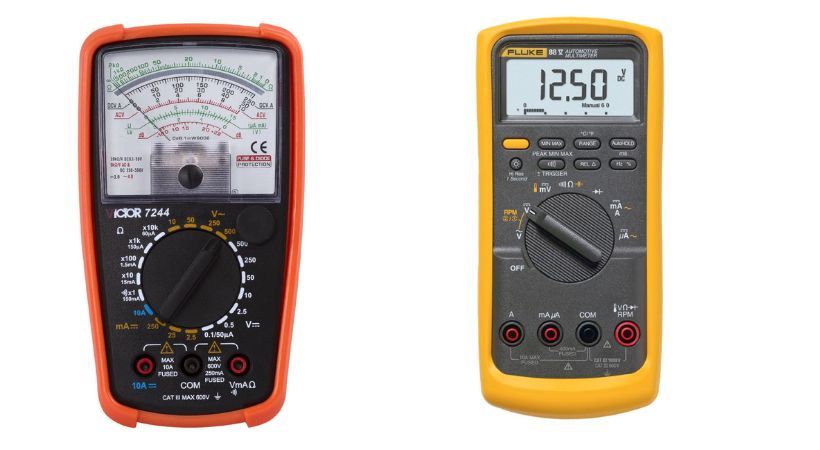
Based on measurement range, the multimeter is also divided into two types: manual and auto range multimeter. In the manual, you have to select the measurement range and in auto, the multimeter automatically picks the range.
The multimeter has various parts and offers various measurement functions. Let’s talk about that in detail for a better understanding of the multimeter.
Parts of the multimeter
The term “parts of a multimeter” typically refers to the individual components or elements that make up a multimeter device.
These parts play specific roles in enabling the multimeter to perform its functions accurately and efficiently.
To perform the measurement accurately and efficiently understanding these parts is essential. Here are some parts or components of the multimeter.
1. Display
The display is one of the primary parts of the multimeter. The multimeter measures the voltage, current, or resistance but where it will show a measured value.
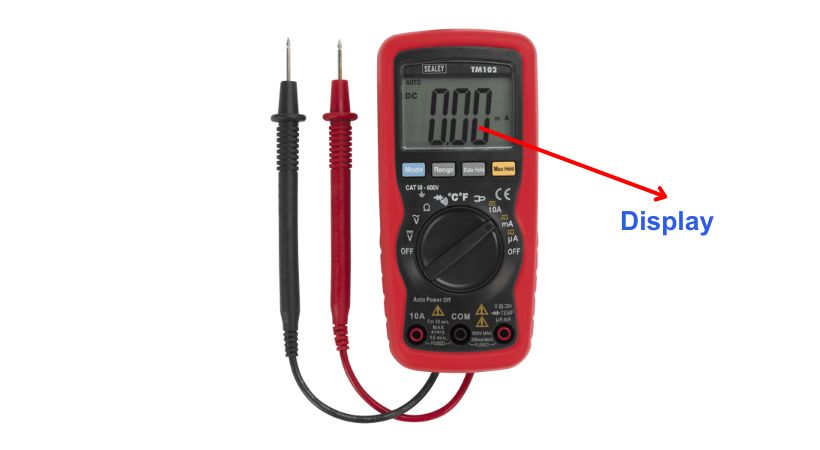
Display the platform provided by the multimeter. In digital multimeters (DMMs), this is typically an LCD screen that displays numerical readings.
Analog multimeters have a dial with a moving pointer indicating measurements on a scale. The digital multimeter display is considered a more efficient and easily read option.
2. Selection dial/function switch
As the multimeter is multi-functional it needs a button or switch that helps in selecting different parameters for measurement.
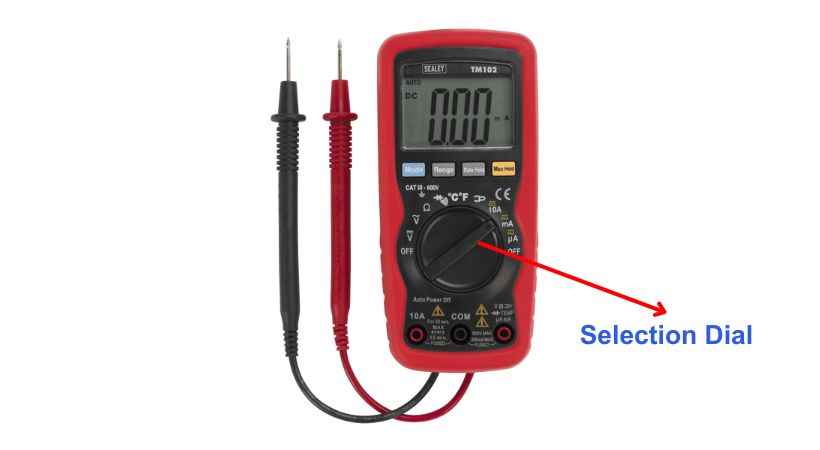
This dial or switch allows users to select the desired measurement function (e.g., voltage, current, resistance) and range.
It’s used to set the multimeter to the appropriate mode for the type of measurement being performed.
3. Input jacks
The input jacks are the crucial part of the multimeter as it is responsible for all the connecting between the meter and the component being tested.
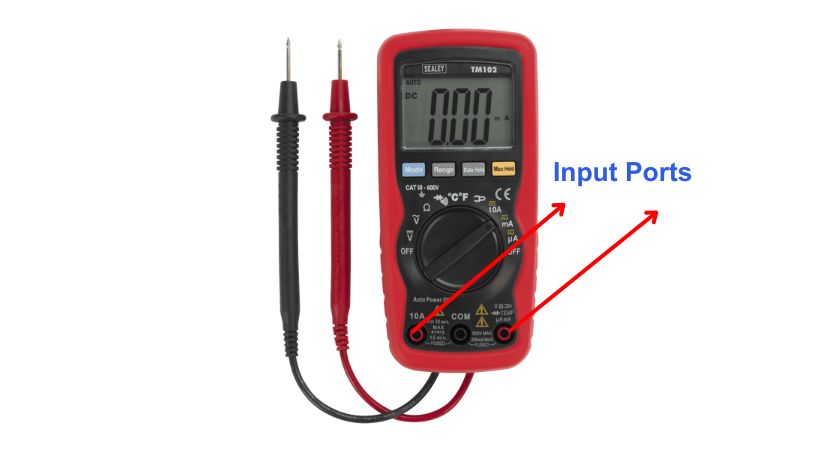
Input jacks are the ports where the test leads (probes) are plugged into the multimeter.
There are typically two jacks: one for the black (negative) lead and one for the red (positive) lead. The jacks are color-coded to match the test leads.
4. Test leads
The test leads are the leads or probes that connect to the multimeter and help in measurements.
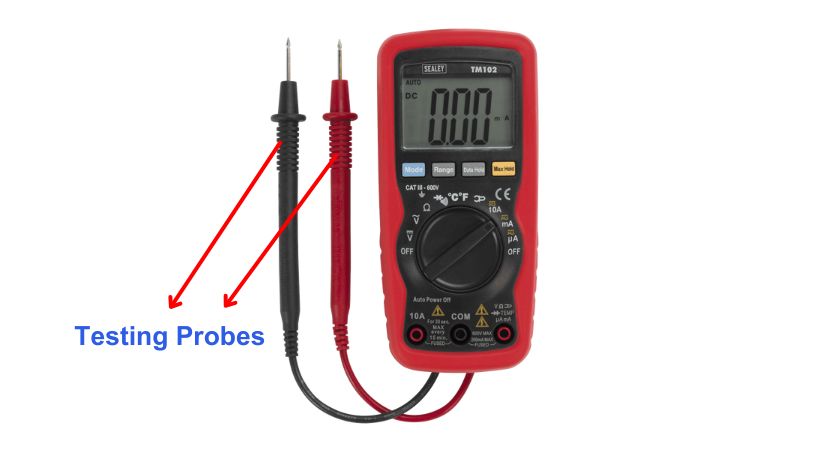
Test leads are flexible cables with probes at the ends used to make electrical connections with the circuit under test.
The black lead is usually connected to the COM (common) jack, while the red lead is connected to the VΩmA (voltage, resistance, current) jack.
5. Function buttons
Some additional features perform specific operations in the digital multimeters.
The operations like data hold, switching between AC (Alternative current) and DC (Direct current) modes, and connectivity options through Bluetooth. For these operations, the multimeter has function buttons.
Functions of multimeters
The functions of a multimeter mean the electrical parameters that a multimeter can measure.
Multimeters typically have several primary functions, each serving a specific purpose in electrical testing and troubleshooting. Let’s explore each function in detail:
1. Voltage measurement
Voltage measurement is the fundamental measurement function offered by a multimeter. It allows us to measure the potential difference between two points in the circuits.
The multimeter measured both AC and DC voltage. You can measure the voltage of direct current sources such as batteries, power supplies, or electronic circuits.
The multimeter can measure the AC voltage in different appliances. You have to set the meter to the voltage mode when intended to measure voltage using a selection dial.
2. Current measurement
Current measurement enables users to measure the flow of electric charge in a circuit. Multimeters can measure both AC and DC.
Current measurements are essential for assessing the load on electrical circuits, checking the current draw of devices, and diagnosing issues related to excessive current flow or insufficient power supply.
Move the selection dial to the current mode, most of the multimeter has ‘A’ on it to show the amper mode and start the current measurement.
3. Resistance measurement
Resistance is the opposition offered to the flow of the current. It controls the flow of current to the components.
The resistance measurement is performed to measure the resistance of a component or conductor in a circuit. Multimeters allow users to measure resistance in ohms (Ω).
It helps in identifying the right resistor for the proper functionality of the circuit and also finds the faulty components.
4. Capacitance measurement
The capacitance is the capacity of the capacitor to store electrical charges. Some multimeters also offer functions like capacitance measurement.
The multimeter charges the capacitor to the known current and measures the voltage. After that, it calculates the capacitance.
The multimeter has a symbol like ‘C’ to represent the capacitance measurement option.
5. Frequency measurement
Frequency measurement on a multimeter allows users to measure the frequency of an alternating current (AC) signal.
This function is particularly useful in electrical and electronic applications where the frequency of a signal is important for analysis, troubleshooting, or calibration.
You have to select the frequency mode on the multimeter on the selection dial. After this connect the probes and the result will be displayed on the screen.
6. Continuity testing
The continuity test function checks for the presence of a continuous electrical connection between two points in a circuit.
When performing a continuity test, the multimeter emits an audible beep or displays a visual indication if continuity is detected.
Continuity testing is useful for verifying the faulty components, and integrity of wires, connections, and circuit paths. It helps identify broken wires, loose connections, or faulty switches.
7. Diode testing
Multimeters also offer functions like diode testing. In this, we check the diode function to make sure it will work fine when connected to the circuit.
When performing a diode test, the multimeter applies a small voltage across the diode and measures the forward voltage drop. It indicates whether the diode is functioning correctly or if it’s faulty or damaged.
The multimeter has a diode symbol on it to indicate the testing of the diode function.
These are some functions that a multimeter offers to measure different electrical parameters. Understanding these functions is essential for troubleshooting circuit problems.
Conclusion
The multimeter is an essential tool in the world of electrical and electronic engineering.
This tool helps in identifying faulty components and finding the value of voltage, current, and resistance in the circuit.
The multimeter has been made by combining the various parts. The parts of the multimeter are
- Display
- Selection dial
- Input jacks
- Test leads
- Function buttons
These are the parts of a multimeter. The multimeter offers various functions for the measurement of various parameters.
The measurement functions of the multimeter are as follows.
- Voltage measurement
- Current measurement
- Resistance measurement
- Frequency measurement
- Continuity testing
- Diode testing
By familiarizing yourself with the parts and functions of a multimeter, you can use your multimeter effectively to measure voltage, current, resistance, and more.
This is about the multimeter parts and functions, I hope you’ll like it.
Thank you and have best life…
Other useful posts:
